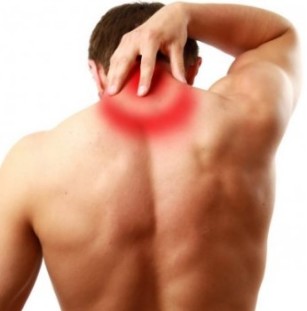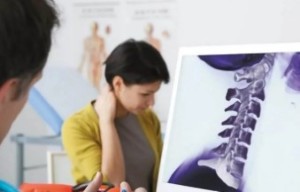Osteochondrosis is a disease of the spine, through the development of the changes in the cartilage of the intervertebral discs and reactive processes in the surrounding tissues.
Cervical osteochondrosis of the spine is different in its manifestations of thoracic and lumbar degenerative disc disease. Symptoms of cervical degenerative disc disease associated with the anatomical features of the cervical spine. The dimensions of the vertebral body of the cervical spine is at least as large as the other departments. The cervical strain is felt, the head, and at the same time it has an enormous mobility.

Causes of osteochondrosis
The reasons for the development of the disease, primarily due to the age-related aging of the organism and the developing destruction of bone and cartilage tissue. Also you can diseases among of the following causes of degenerative disc:
- Posture,
- decreased locomotor activity as a result of lack of exercise,
- obesity is the result of metabolic disorders, the effect of the load on the intervertebral discs,
- Hereditary factor,
- long-lasting physical stress,
- Malformations of the spine.
Consistent physical activity, proper nutrition and a healthy way of life significantly the likelihood of developing this disease, as well as reducing the impact on the General well-being reduce.
Symptoms of cervical degenerative disc diseases of the spine
Symptoms of cervical degenerative disc disease differ from the symptoms in other areas of the spine. This is due to the fact that the cervical vertebrae have a different structure and are very close. Therefore, each shift is manifested by severe pain. In addition, in the area of the cervical spine is often pinched nervous bundles and arteries.
Cervical osteochondrosis of the spine shows the following symptoms:
- Sensations of pain – the pain can be felt in different parts of the body. This is due to the fact that it happens to pinched nerves and muscles of the corresponding body part.
- Weakness in the upper limbs – due to pinched nerve endings, which for the motor.
- Difficulty in turning the head, the occurrence of crackling vertebrae in the cervical spine may occur due to changes in the structure of the intervertebral disc, the emergence of the bony formations.
- Low sensitivity of the hands.
- Weakness and dizziness occur, because of the pinching of the arteries, the flow of blood and nutrition to the brain.
- Hearing impairment, and vision appears in the last stage of the disease, when the blood flow in the cerebellum.
Signs of degenerative disc disease of the cervical spine
- Radicular syndrome – characterized by a pinched nerve bundle in the neck. Manifests itself by severe pain that can be felt in the shoulders, the shoulder blade.
- Vertebral artery syndrome – the most headaches, pain in the temples and nape of the neck.
- Reflex syndrome – characterized by severe pain in the cervical spine, which can be reinforced with each movement of the head. Pain in the shoulder can move, and on the chest.
- Cardinal-syndrome – reminiscent of Angina, to determine the extremely difficult.
Degree of development of cervical degenerative disc diseases of the spine
As it develops, the disease goes through several stages. Each stage has its peculiarities and is characterized by certain features.
- Level 1. Bone and cartilage of the spine gradually begins to crumble. The symptoms of the disease are not clearly visible. And very often the patients do not notice you, and bind the fatigue and pain with fatigue and Stress.
- 2 Phase. To fall after the height of the disc begins to appear in the cracks. The Patient has prolonged pain, weakness, numbness of the face.
- 3 stage. To form hernias, transection of the cervical vessels and muscles. There are complaints of dizziness, pain in the neck.
- 4 Phase. The bone tissue of the vertebrae of unnecessary loads, protects begins to proliferate, allowing the nerves to be pinched ends. Stiffness occurs in the movements, damage to the adjacent joints.
The danger of cervical degenerative disc disease
In the neck area of a large number of nerves and arteries located the a diet the brain. In the case of the infringement of their work, the brain does not receive enough current for normal operation. In this Situation, the motor activity of the people, disturb can cause pain in the extremities, and loss of coordination.
In an advanced stage of osteochondrosis can develop, ischemia, stroke and many other diseases dangerous to human life.
Therefore, if you visit any of the symptoms associated with this disease, we recommend the doctor.
Diagnostics of the cervical spine
For the investigation of diseases of the spine uses the following types of diagnoses:
- X – ray is an inefficient way, the diagnosis of the disease,
- MRI (magnetic resonance imaging)shows the bony structures, the intervertebral disc incidents and their dimensions,
- CT (computed tomography) is ineffective compared with the MRI, because with the help of this method, the diagnosis is difficult, the dimensions of the brche,
- Duplex ultrasound is used when the blood is disturbed. This survey shows the existing speed of blood flow, as well as the presence of obstacles on his way.
The treatment of cervical osteochondrosis of the spine

The treatment of cervical osteochondrosis of the spine should be in the system depending on the Situation. The positive effect can be achieved by a holistic and personal care, which includes drug therapy, physiotherapy treatments, exercise therapy, Massage, are also the means of traditional medicine.
In the period of acute treatment of cervical degenerative disc diseases of the spine aims to improve the blood circulation, eliminate muscle spasms. In this case, the means for the improvement of blood circulation, anti-inflammatory and painkiller, Vitamin-complex ordered.
Medical gymnastics in osteochondrosis of the cervical spine
Physiotherapy gives visible results and less dangerous on the stage of recovery. The effect of physiotherapy is the restoration of blood flow to the damaged body. The exercises of physiotherapy, the Patient should not feel pain and discomfort.
A series of exercises for the cervical spine designed to strengthen the neck muscles, as well as the role of prevention for the development of cervical degenerative disc disease.
Massage in osteochondrosis of the cervical spine
The Massage will relieve with the aim of strengthening the Tonus in the muscles and pain. Depending on the stage of the disease, different techniques of Massage. To the classical techniques of Massage:
- stroking – this technique is the effect on the superficial layers of the skin. The Massage begins with the neck area and consists of the clavicle and the armpit.
- Pushups – in this case, the effects of Massage are found on the deeper layers of the skin. Cross over the neck with the thumb and index finger movement to the seizure of the skin, such as bruising lead.
- Attrition – occurs with the target, warm-up and relax the skin, in order to improve the blood circulation in the neck area of the cervical spine.
- kneading – has special limitations because it acts on the underlying tissue. In the case of improper execution of this technique can damage the patient.
In cases where the Patient is the feeling of pain occurs only on one side, perform the Massage, you should start with a healthy part of the neck, the spine gradually in that part of the neck where there is pain.
Massage can be performed at home and in a medical facility. However, in the course of the reaction, the exacerbation of the disease or make it worse should be very careful not to provoke.
Preventing the development of cervical degenerative disc disease
To prevent the formation and development of the disease, it is recommended that you follow the simple rules:
- a healthy way of life, physical activity, regularly in the swimming pool;
- Diversification of the diet of foods rich in Magnesium and calcium;
- in the case of the with sedentary activities, you have to do several times a day, warm-up;
- to sleep, you should get the mattress and comfy pillows.


















